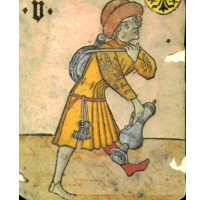Breeches
Breeches are an item of male clothing covering the body from the waist down, with separate coverings for each leg, stopping anywhere between the knee and the ankles.
Breeches are often associated with the social function of breeching of a young boy, which occurred at an age somewhere between six and eight as recently as the early 20th century. Breeching involved giving a boy his own pair of breeches for the first time, instead of the gowns and dresses worn by all genders as infants. It was considered a major rite of passage.
In history
Until the early Middle Ages, breeches were synonymous with braies. During the Middle Ages, and for much of the sixteenth century, men covered their legs with hose, but a looser form of breeches was sometimes to be seen. It was from the late sixteenth century that men began to wear breeches and they continued to do so until these were slowly replaced by modern trousers. During this long period, many different styles went i and out of fashion, but each varying in fullness, length, and cut, as well as in fabrics used.
In the late 16th and early 17th century, breeches were full and often padded. The full, loose designs were known as [[slops], and were usually finished at the knee with a tied, fringed sash. Similar were the German pluderhosen, with their generally padded shape that narrowed in pear form towards the knee.
Cloak-bag breeches were an early 17th century design. Oval in shape, these were full, unpadded, and were drawn in at a little above the knee, where they were finished by decorative points or lace. In the 1630s came the longer full breeches, unpadded and ending below the knee with ribbon loops. Sometimes this style, often known as Spanish hose, was pulled in close at the bottom, sometimes it was left open. Side seams were often decorated by braid or buttons.
